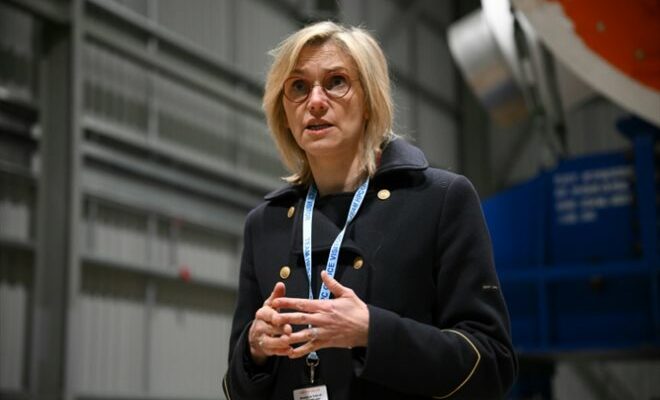The 245 tonne steel dome on the first Hinkley Point C reactor building, at Hinkley Point nuclear power station, near Bridgewater, southwest England, in a photograph released by EDF Energy on December 15, 2023 (EDF ENGRY/AFP/Archives/Handout)
New setbacks for the EPR, the flagship of French nuclear power: the construction of the first new generation reactor at the Hinkley Point C power plant in England is expected to be delayed between two and four years and the initial bill almost doubled. .
The commissioning of the first EPR at Hinkley Point C has now been postponed by at least two years, or even four years, or at best to “2029”, or even “2030” or “2031”, the manufacturer EDF announced on Tuesday.
Located in Somerset in the southwest of England, the Hinkley Point C site, largely supported by the French group, is not in its first slip-ups.
First scheduled for the end of 2025, the start-up of the first reactor had already been postponed to June 2027, with a forecast risk of delay of 15 months. The delay will ultimately be 24 months, in the best case.
The French electrician indicates that he has increased the duration of electro-mechanical assembly work (cables and pipes) at a time when this phase is just beginning. Scheduled to last 28 months, this stage will ultimately take 52, thus adding two years to the total duration of the project.
Depending on the scenarios, favorable or central – the most probable according to EDF – on the realization of this assembly plan, the reactor could thus start either in 2029 or in 2030.
But “given the complexity of the project” EDF has also planned “an unfavorable scenario” which “could lead to the start of electricity production from Unit 1 in 2031”, he said in a press release. .
Longer therefore more expensive: the project’s cost is now “estimated in a range between 31 and 34 billion pounds in 2015 value”, announced the energy company, specifying that the costs in 2023 value are currently being estimated.
This represents an additional cost of 6 to 8 billion pounds (7 to 9.3 billion euros) compared to the last revision which dates back to 2022. EDF then reassessed the project at 25-26 billion in 2015 pounds, compared to 18 billion estimated at the start of the project in 2016.
This new delay comes at a time when EDF announces its intention to build “1 to 1.5” reactors per year in the next decade. It then happens that the manufacturer has still not delivered Flamanville 3, its very first EPR, to France, which is 12 years late and has quadrupled the bill. It must be connected by mid-2024.
“The EDF teams have the confidence of the French government both for this British project and for the numerous power plants which will soon be built in France”, reacted to AFP the Ministry of the Economy which is also responsible for Energy.
– Other financial “partners”? –
With inflation, Hinkley Point’s costs could rise further, and EDF could have to bear them alone, due to lack of participation by its Chinese partner CGN in additional costs.

Former French Minister for Energy Transition, Agnès Pannier-Runacher, visits the Hinkley Point C nuclear power plant, near Bridgwater, in the southwest of England, on April 27, 2023 (AFP/Archives/Daniel LEAL)
EDF said it hoped to “attract other partners for this project”, a process which “will take time”, but which has “no implication either on the timetable or on the cost”.
Today, the electrician is pleased to have completed 60% of the construction work on the buildings, a phase which reached a major milestone in December with the spectacular installation of the steel dome on the reactor building.
According to him, this new postponement of the schedule is solely linked to the reassessment of the duration of the electro-mechanical assembly work, “compared to the duration (…) estimated at the time of the investment decision” in 2016, a duration which had “never been reviewed” for this phase.
Asked about the lack of specialized labor at a time when European countries want to relaunch nuclear power, the company indicates that it has “made the assumption of being able to find the qualifications” required.
“But if we cannot find enough people quickly enough, this could cause a few additional small delays,” admitted EDF.
Started in 2017, the construction of the two 3.2 gigawatt reactors, capable of powering six million homes, is now involving 11,000 people. As a result of the new deadlines for Unit 1, the construction of the 2nd unit, which was scheduled to start in June 2028, should also experience a one-year delay.
© 2024 AFP
Did you like this article ? Share it with your friends using the buttons below.




